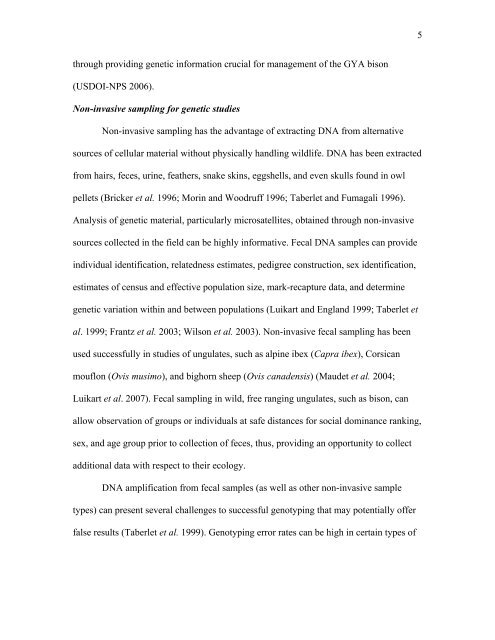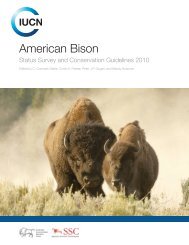Declaration Dr. Thomas H. Pringle - Buffalo Field Campaign
Declaration Dr. Thomas H. Pringle - Buffalo Field Campaign
Declaration Dr. Thomas H. Pringle - Buffalo Field Campaign
Create successful ePaper yourself
Turn your PDF publications into a flip-book with our unique Google optimized e-Paper software.
through providing genetic information crucial for management of the GYA bison<br />
(USDOI-NPS 2006).<br />
Non-invasive sampling for genetic studies<br />
Non-invasive sampling has the advantage of extracting DNA from alternative<br />
sources of cellular material without physically handling wildlife. DNA has been extracted<br />
from hairs, feces, urine, feathers, snake skins, eggshells, and even skulls found in owl<br />
pellets (Bricker et al. 1996; Morin and Woodruff 1996; Taberlet and Fumagali 1996).<br />
Analysis of genetic material, particularly microsatellites, obtained through non-invasive<br />
sources collected in the field can be highly informative. Fecal DNA samples can provide<br />
individual identification, relatedness estimates, pedigree construction, sex identification,<br />
estimates of census and effective population size, mark-recapture data, and determine<br />
genetic variation within and between populations (Luikart and England 1999; Taberlet et<br />
al. 1999; Frantz et al. 2003; Wilson et al. 2003). Non-invasive fecal sampling has been<br />
used successfully in studies of ungulates, such as alpine ibex (Capra ibex), Corsican<br />
mouflon (Ovis musimo), and bighorn sheep (Ovis canadensis) (Maudet et al. 2004;<br />
Luikart et al. 2007). Fecal sampling in wild, free ranging ungulates, such as bison, can<br />
allow observation of groups or individuals at safe distances for social dominance ranking,<br />
sex, and age group prior to collection of feces, thus, providing an opportunity to collect<br />
additional data with respect to their ecology.<br />
DNA amplification from fecal samples (as well as other non-invasive sample<br />
types) can present several challenges to successful genotyping that may potentially offer<br />
false results (Taberlet et al. 1999). Genotyping error rates can be high in certain types of<br />
5










